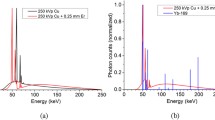Abstract
We introduce a new effective method to control hormone-refractory prostate cancer cells using an activated rubber/resin form (RB), far-infrared ray (FIR) emitter, with or without sodium butyrate treatment (NaB). The growth of three human prostate cancer cell lines (Du145, PC-3 and LNCaP) was suppressed in vitro and vivo by FIR, and the cells were eradicated with FIR + 3 mM NaB. G1 arrest and apoptotic pathway proteins were induced by FIR with elevated expressions of apoptosis-related transcripts in cDNA microarray. RB reflects and radiates in the wavelengths of about 4 to 25 µm in the FIR that work to suppress the growth of human prostate cancer cells. Accordingly, this technique may be used as a new therapeutic treatment in hormone-refractory prostate cancer.
Similar content being viewed by others
References
Jemal A., Siegel R., Ward E., Murray T., Xu J., Thun M.J., Cancer statistics, 2007, CA Cancer J. Clin., 2007, 57, 43–66
Yagoda A., Petrylak D., Cytotoxic chemotherapy for advanced hormone-resistant prostate cancer, Cancer, 1993, 71, 1098–1109
Petrylak D.P., Docetaxel-based chemotherapy trials in androgen-independent prostate cancer: first demonstration of a survival benefit, Curr. Oncol. Rep., 2005, 7, 205–206
Prosperi J.R., Robertson F.M., Cyclooxygenase-2 directly regulates gene expression of P450 Cyp19 aromatase promoter regions pII, pI.3 and pI.7 and estradiol production in human breast tumor cells, Prostaglandins Other Lipid Mediat., 2006, 81, 55–70
Schoensiegel F., Paschen A., Sieger S., Eskerski H., Mier W., Rothfels H., et al., MIA (melanoma inhibitory activity) promoter mediated tissue-specific suicide gene therapy of malignant melanoma, Cancer Gene Ther., 2004, 11, 408–418
Rao M.K., Maiti S., Ananthaswamy H.N., Wilkinson M.F., A highly active homeobox gene promoter regulated by Ets and Sp1 family members in normal granulosa cells and diverse tumor cell types, J. Biol. Chem., 2002, 277, 26036–26045
Frebourg T., Kassel J., Lam K.T., Gryka M.A., Barbier N., Andersen T.I., et al., Germ-line mutations of the p53 tumor suppressor gene in patients with high risk for cancer inactivate the p53 protein, Proc. Natl. Acad. Sci. USA, 1992, 89, 6413–6417
Karam J.A., Lotan Y., Ashfaq R., Sagalowsky A.I., Shariat S.F., Survivin expression in patients with non-muscle-invasive urothelial cell carcinoma of the bladder, Urology, 2007, 70, 482–486
Horoszewicz J.S., Leong S.S., Chu T.M., Wajsman Z.L., Friedman M., Papsidero L., et al., The LNCaP cell line—a new model for studies on human prostatic carcinoma, Prog. Clin. Biol. Res., 1980, 37, 115–132
Kaighn M.E., Narayan K.S., Ohnuki Y., Lechner J.F., Jones L.W., Establishment and characterization of a human prostatic carcinoma cell line (PC-3), Invest. Urol., 1979, 17, 16–23
Roccatano D., Sahoo H., Zacharias M., Nau W.M., Temperature dependence of looping rates in a short peptide, J. Phys. Chem. B, 2007,111, 2639–2646
Binaschi M., Zunino F., Capranico G., Mechanism of action of DNA topoisomerase inhibitors, Stem Cells, 1995, 13, 369–379
Maier S., Reich E., Martin R., Bachem M., Altug V., Hautmann R.E., et al., Tributyrin induces differentiation, growth arrest and apoptosis in androgen-sensitive and androgen-resistant human prostate cancer cell lines, Int. J. Cancer, 2000, 88, 245–251
Li H., Cao H.F., Li Y., Zhu M.L., Wan J., Changes in gene-expression profiles of colon carcinoma cells induced by wild type K-ras2, World J. Gastroenterol., 2007,13, 4620–4625
Ito Y., Akinaga A., Yamanaka K., Nakagawa T., Kondo A., Dickson R.B., et al., Co-expression of matriptase and N-acetylglucosaminyltransferase V in thyroid cancer tissues—its possible role in prolonged stability in vivo by aberrant glycosylation, Glycobiology, 2006, 16, 368–374
Bedner E., Li X., Gorczyca W., Melamed M.R., Darzynkiewicz Z., Analysis of apoptosis by laser scanning cytometry, Cytometry, 1999, 35, 181–195
Shibata M.A., Ito Y., Morimoto J., Otsuki Y., Lovastatin inhibits tumor growth and lung metastasis in mouse mammary carcinoma model: a p53-independent mitochondrial-mediated apoptotic mechanism, Carcinogenesis, 2004, 25, 1887–1898
Klisovic D.D., Katz S.E., Effron D., Klisovic M.I., Wickham J., Parthun M.R., et al., Depsipeptide (FR901228) inhibits proliferation and induces apoptosis in primary and metastatic human uveal melanoma cell lines, Invest. Ophthalmol. Vis. Sci., 2003, 44, 2390–2398
Wiese L., Kurtzhals J.A., Penkowa M., Neuronal apoptosis, metallothionein expression and proinflammatory responses during cerebral malaria in mice, Exp. Neurol., 2006, 200, 216–226
International Human Genome Sequencing Consortium, Finishing the euchromatic sequence of the human genome, Nature, 2004, 431, 931–945
Burzynski S.R., Aging: gene silencing or gene activation?, Med Hypotheses, 2005, 64, 201–208
Struhl K., Histone acetylation and transcriptional regulatory mechanisms. Genes Dev., 1998, 12, 599–606
Planck M., Ueber das Gesetz der Energieverteilung im Normalspectrum, von Max Planck. Ann. d. Phys., 1900, 4, 553–563, (in German)
Arrenhius S., Über die Reaktionsgeschwindigkeit bei der Inversion von Rohrzucher durch Säuren, Z. Phys., Chem., 1889, 4, 226–248, (in German)
Bruckheimer E.M., Kyprianou N., Apoptosis in prostate carcinogenesis. A growth regulator and a therapeutic target, Cell Tissue Res., 2000, 301, 153–162
Peehl D.M., Primary cell cultures as models of prostate cancer development, Endocr. Relat. Cancer, 2005,12, 19–47
Gurumurthy S., Vasudevan K.M., Rangnekar V.M., Regulation of apoptosis in prostate cancer, Cancer Metastasis Rev., 2001, 20, 225–243
Author information
Authors and Affiliations
Corresponding author
About this article
Cite this article
Shima, H., Yamamoto, S., Qiu, J. et al. Far-infrared rays control prostate cancer cells in vitro and in vivo . cent.eur.j.biol. 5, 178–189 (2010). https://doi.org/10.2478/s11535-010-0003-7
Received:
Accepted:
Published:
Issue Date:
DOI: https://doi.org/10.2478/s11535-010-0003-7




